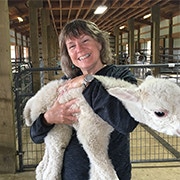Sep. 19, 2023
•9 min read
As I write this article, Racine artist and painter Jerry Belland is sitting in a vitrectomy recovery chair, a contraption designed so that its occupant sits leaning forward, with their face down and parallel to the floor. Belland will have to sit in this chair for at least 48-hours following surgery to repair a macular retinal hole in his left eye. At the time of our interview, however, Belland was sitting face up at his Racine studio at 1515 16th Street, a once-empty industrial space that is now a communal creative space to dozens of Racine-area artists.
As Belland and I prepare to talk, the exposed pipes in the studio ceiling hold their cacophonous clickety-clackety conversation with the heavy cast-iron steam heat radiators along the walls, clanging in response. I settle into an overstuffed chair, while Belland makes himself at home on a green checkered sofa. The space is welcoming, but unpretentious; pragmatic with a hint of clutter.
Belland comes from an upbringing not very unlike my own. He was raised on a dairy farm near Zenda, Wisconsin, back when cows actually grazed in open fields and happily listened to rock music while being milked. (Fun fact, cows actually give more milk when music is playing.) After graduating from UW-Madison with a B.A. in Art Education, and from UW-Milwaukee with a Master of Arts, Belland worked for decades teaching art classes at Horlick High School in Racine, until his retirement over a decade ago.
Belland’s job as a farm boy was to carry the buckets of warm “moo juice” up to the stainless-steel holding tank, dump the milk in, then wait for the next cows to be milked when his dad would summon him to carry more. He spent the time in between emptying buckets studying art and artists, including Mad Magazine artists like Mort Drucker and Al Jaffe.
“I’d have a half an hour or 45 minutes, so I had this little cubby hole where I had a stool with magazines,” Belland said. “It wrecked the magazines, but I had them in there and I could just study one panel. I’d think, Could I draw that? or, How did he do that?”
While the Belland cows were just groovin’ to the music playing on the green Philco radio that was positioned high atop a shelf in the barn, the boy Belland was listening intently to the words of a new up-and-coming musician and poet by the name of Bob Dylan. “I’m marching along with my milk pails and Bob Dylan’s, Like A Rolling Stone, came on,” Belland recalled. “I’d never heard it before. But I knew there was no going up to dump the milk. I just set those pails down right there, right underneath that radio, and I sat frozen in place. It was thrilling. It really was thrilling. And Bob Dylan to me has always been the gold standard, a pop genius.”
Admirer of musicians and poets. Farm boy. Man sitting for two days, face down in a chair. This story could go in many directions, but at its heart, it’s a story about an artist who has dedicated his life to art. Studying it. Teaching it. Making it.
Belland paints, draws, doodles, sketches every day, and has for almost 70 years. In that time his style has taken a few twists and turns. From pinup girls, to religious satire, to political commentary, his love of Chicago Tribune Sunday comics, Mad Magazine, and other cartoon art oozes from his brushes and pens. He often, like the cartoonists he’s so long admired, inscribes short narratives on his paintings and drawings, as an added humorous commentary. A self-portrait shows Belland holding a sign that reads, “I will do meaningful figurative paintings for food.” Another drawing is of a Siamese cat who thinks, “The meaning of life is here somewhere,” followed by a caption, “Siamese cats are reincarnated Buddhist monks.” Belland himself is part Buddhist, part Christian, part “I admit I have no idea.”
Lately, his visual direction has shifted fairly dramatically, with more focus on still life work which has a far less lively tone than his colorful cartoon-type work. Belland is currently working on a series of paintings of the mixed industrial and residential lower-income neighborhoods that sprawl outside the windows of his studio. These paintings take on a more muted and “assembled” look. If you saw a Belland on the wall from 10 years ago next to one from a few months ago, you’d have a difficult time discerning that the same artist was holding the brush.
“At some point, maybe we just start repeating ourselves too much. Like you just become too predictable. I know many artists like that. From across the room, you can spot their work. They got their whole thing down, ya know. And they’ve got an award over here and they sold something over there. And so that’s what they do. So yeah, there was a conscious decision to sort of walk away from that,” Belland explained.
He walked away from predictability in his art because, well, Belland isn’t predictable. He hates getting stuck in a creative routine for very long. He admits that being a high school art teacher for over 40 years and having to teach the same classes over and over again was far too prosaic and monotonous. It’s not that he didn’t love teaching many of his students, some of whom have gone on to become successful artists themselves. Still, he calls teaching high school a “51/49” situation. 51 percent of the time it was rewarding. 49 percent of the time it was drudgery. “Routine”, said Belland. “I taught contour drawing so many times, it was just ridiculous. And I do believe it got harder as years went by, in that kids had less of an attention span. It also could have been for personal reasons, you know. Here I was, an old coot up there. But, yeah, it was very rewarding.”
Belland said he plans on doing another still life from the vantage point of some yet-to-be-determined window in the building where his studio is located. He has yet to sell any of these particular paintings, but he says that’s not the point of painting them, nor, perhaps surprisingly, does he get a lot of enjoyment from the process of painting them. The end product is why he keeps doing it. Of his neighborhood still life work, Belland said, “I can’t say I like doing them. Not particularly. But I like the way they look. I like the result. At what point does the marketplace …”, he continues, “If the marketplace were an issue, I wouldn’t be making a big painting like that. I truly doubt if I’m going to sell that painting. But I like the painting.”
Racine itself is a very tight-knit art community; everybody knows everybody. Belland says it took him a long time in his artistic career to get to a place where he felt welcomed and rewarded, and until he felt that he was part of the Racine artistic community and conversation. Today, Belland is beginning to see some recognition and feel a sense of belonging to the community where he has lived, taught, raised his family, and worked all his life. The Racine Art Museum has about ten of his pieces in its collection and may soon be adding more. One of his earlier works was included in a 2021 book, A Creative Place: The History of Wisconsin Art, and in the last 20 years, Belland has had numerous openings and shows in the Racine and southeast Wisconsin area. In summer 2023, OS Projects, a gallery in downtown Racine, will feature the works of Belland and one of his former Horlick High School students, Andy Larson, in a generational exhibit. Larson is now a successful artist in Chicago.
“And that’s its own reward,” admits Belland. “It took forever. It took 15 years before I became part of the conversation, let’s put it that way.”
It’s now 2:00 on a Friday afternoon. Neither of us has any place we want or need to be. Belland steps into a back room, comes out with a stainless-steel cocktail shaker, pours some liquid into two big, red plastic cups, and hands me one. A few sips and the conversation takes on an entirely new dimension. It comes back to his impending eye surgery. For the last few days, he tells me, it’s not only consumed his mind, but it has disrupted his routine with a laborious series of activities that he must undergo in preparation. The hope is the surgery will restore or at least arrest the vision loss in his eye. Belland admits that ever since a routine gallbladder surgery a few years ago, which ended up far from routine, he is especially nervous about this surgery. While he doesn’t use the term, “near-death experience” this is what Belland describes happened to him following the gall bladder surgery when his blood pressure dropped suddenly and precipitously.
“The experience was like sinking down into water, you know, like going to the bottom of the ocean very slowly. I think I had an image of myself just descending through the ocean, kind of down-down-down-down-down. And then I got to the bottom.” Belland pauses, and then continues. "And I’m looking around and there’s a door. And it’s like an airplane fuselage door. And there’s light emanating from around it. And I looked at it and I said, ‘Well that’s where you go when you die.’ (Laughs) And I said, ‘Gee, I’m not going to go there now. But wow. That’s where you go when you die. Right there.’"
We sip a little more and let that all sink in.
Belland explained how that experience changed him. At 74, he no longer fears death, but admits that after that experience, he was depressed for a number of days. Everything in his world seemed so small; literally small and insignificant. But as the depression lifted, he said he felt a sense of reinvigoration and an urgency to tell people close to him to live their lives to the fullest and to not settle for the mundane. Change what you can change to make life better. Leave the rest behind.
“I had an advantage as a public school teacher, you know. I was constantly in the humiliation of being a public school teacher, but it really did … it kept me humble.”
Belland came from humble beginnings. Raised on a farm carrying buckets of milk while listening to Bob Dylan on a green Philco radio. Flying below the radar of the art scene for years while yearning to become some part of it. And now, sitting face down in a chair waiting for his eyes to clear so he can pick up a brush and once again, put paint to canvas. Like the Siamese cat in the drawing mused, “The meaning of life is here somewhere.” For Belland, that meaning is art.
More Articles by Joette Rockow
May. 23, 2023
•8 min read
Apr. 25, 2023
•9 min read
Jul. 13, 2022
•8 min read
About the author
Joette is a Senior Lecturer at UW-Milwaukee where she teaches advertising, public relations, and common sense. She is a writer, musician, Taoist, animal lover, and enjoys a good hike, a cold beer, and a belly laugh with friends.





